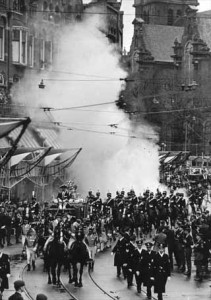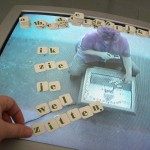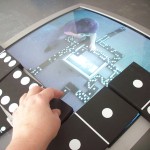Quotes on subversive games
 Subversive games: quotes on Dada, Surrealists, Fluxus, Situationists, Provo
Subversive games: quotes on Dada, Surrealists, Fluxus, Situationists, Provo
“Banding together in the heart of Europe during World War I, the Dadaists’ aim was to give voice to “a raucous skepticism about accepted values”. While Dada emerged in Zurich, Paris, Berlin, Hanover, Cologne and New York in differing ways, consistent Dada innovations include the creation of a global network of artists who used new forms to communicate and to create art itself.’ [Critical play page 37/38]
The Surrealists followed: “Surrealists emphasized the playfulness of Dada through the use of chance and justaposition. But Surrealists were also concern with the internal workings of the mind and encouraged a deep focus on the subconscious.” [Critical play page 89] “To twentieth-century critic Walter Benjamin, it is only through the intensification of everyday experiences that social change can occur. Play, in this case, could function not only to attract players from across the social spectrum but also to revolutionize culture by expressing what might otherwise manifest as dangerously repressed desires. It is precisely such psychic needs that were explored by the Surrealists through gaming operations and game methods.” [Critical play page 89]
Then on came Fluxus: “In a further insight, the avant-gardists of the Fluxus group in the 1960s to 1970s saw the forces of critcal play – unplaying, reskinning and rewriting – as the most urgent quality of art itself. Much like the earlier Dadaists, Fluxus represented an international web of artists who connected to each other and their followers through every type of medium and discipline imaginable. Games, bound by limited information, an emphasis on play, and a manifestation as either closed or open systems, struck Fluxus artists as a natural path for the creation of a vocabulary based on, or explicitly outside, popular cultural rules and expectations. Fluxus artists were quick to see that games lay between the rational and the absurd, between mobility and fixed trajectories, and between logic and chance. Furthermore, Fluxus artists understood games as processes as well as outcomes, capable of disseminating the most elusive of Fluxus ideas. Opposed to seriousness and the ossification of art as object, Fluxus artists sought a new art practice, one that was open to humor, intimacy, player agency, and various aspects of performance. “Because games lend themselves to humor, often rquire physical participation, and undermine the seriousness of art that certain Fluxus artists opposed, they were a perfect medium for Fluxus expression and experimentation.”
Parallel in time were the Situationists: “Perhaps most well known of the activist-artists were the members of the Situationist International movement, a movement that described both a philosophy of space as well as political action. Formed in Italy (1957) by thinkers and artists of diverse practices, the various factions of the group were a force in political art until the 1970s. “[page 194]. Drawing inspiration from Dada and Surrealism, the Situationists were interested in the banal, everyday acts of urban life that could be subverted in a radical redefinition of everyday experience. “Guy Debord, .. , and famed fro his later ideas that society ahs now become a society based entirely on shock and grandiose display, called for the practice of “psychogeography” to consciously docuemnt the experience of environment and geography on emtions, thinking processes, and behaviour. One of the significant intentions behind psychogeography, as Debord described it, was to be mindful of space in the method’s open-ended, deliberately vague mission of encouraging people to explore their environment, usually the streets of the city. Psychogeography provided a means for participants to open themselves up to play and cance in context. It was a method of studying the world, combining compelling, inventive proposals with “the long-term aim of transforming ‘the whole of life into an exiting game’ – the play principle before the work principle.” [page 195] . Who after all really has unrestricted movement on roads, or in large cities? Which members of society have the time to follow whatever direction their curiosity takes? Who is really able to wander and drift? While these limitations do detract from the potential of the SI members’ efforts toward radical social and political change, theirs was still a movement founded in Marxist ideology, serving to critique a commodity-driven culture and a growing bourgeoisie that allowed the consumption of both space and objects by a voracious cultural and economic machine.” [page 197]
And now for a Dutch movement: Provo. Quotes taken from ‘Brilliant Orange’, a book on the Dutch football successes between 1960 and 2000:
“By the summer of 1965 Grootveld’s shows were the focus for a new group, the white-clad Provo’s, Amsterdam’s archetypal 1960’s anarchists, who mixed surreal anti-authoritarian pranks with anti-consumerism and loopy techno-optimism. The Provos looked upon playfulness – ludiek in Dutch – as the key to a better world. The Provo writer Constant Nieuwenhuis laid out this much-quoted vision for a ‘New Babylon’: ‘.. a world city of leasure and creativity, spreading in all directions, and developing the globe like a net, 50 ft above ground level, leaving the ground for agriculture, nature and highways. Under New Babylonic circumstances, the lust for aggression in mankind will be sublimated into a lust for playfulness… This is the only alternative for mankind if it is not to be wiped out by wars … The mechanised world of cybernetics and automation will leave much leisure time, and in this free time, a man will establish his own settlement in collective creativity.’ [page 14]
The high point of Provo influence came in 1966, two years earlier than the evenements that convulsed Paris in 1968 but similar in impact. In Holland, though, revolution was more cultural than political – and was never followed by a Gaullist, Nixonian of Thatcherite backlash. The pivotal moment came when Princess (now Queen) Beatrix announced plans to marry in Amsterdam a German aristocrat called Claus von Amsberg who had served in the Wehrmacht. Republican-minded Provos and students tapped into popular anti-German sentiment and sowed wild rumours of their plans to disrupt the ceremony. They would put LSD in the water supply or feed it to the horses pulling the royal wedding carriage. Or lion dung would be smeared on the streets to panic the horses. Or laughing gas would be pumped into the church from the organ. On 10 March, the day of the lavish wedding, the TV-watching public saw their screens turn white as Provo smoke bombs went off at the Raadhuisstraat. The police, as was now their custom to do, waded in and started beating people up – much to the shock of the TV audience. While Beatrix and Claus exchanged vows, riots raged.”
Three months later the capital once again convulsed as communist workers and Provos momentarily joined forces. When workers took to the streets over holiday pay, the protests led to more fights with police around the Dam. One worker, Jan Weggelaat, died of a heart attack.. When De Telegraaf claimed the dead man had been hit by stones thrown by his colleagues, new riots erupted outside the newspaper building. The authorities panickede, declared a state of emergency and brought in 1400 national and military police. [page 20]
British anarchist Charles Radcliffe made a day-trip to Amsterdam just after the riots, and in an article published in a Provo pamphlet captured the mood of the city at this time of change: ‘The airport is dull and provincial and it is difficult to believe anything can ever really have happened here … The recent riots add a curiously ambiguous touch to Amsterdam’s essentially placid, patient nature”. Authorities adapted their approach, moving with the times instead of against them. “Without police to hit them, the Provos meanwhile rapidly became irrellevant.” [page 21]
These are the playful art movements of the past century. How about subversive gaming today?
“Today, artist borrow freely from mapping and location technologies for creative purposes.” [Critical play, page 189] Intel reserchers of ubiquitous computing recently helped organize the Inter-Society for Electronic Arts festival in 2006, noting that ‘the contemporary city is weighted down. We can no longer technologically or socially be constrained by something planned and canned, like another confectionary spectacle. We dream of something more, something that can respond to our dreams. Something that will transform with us.” As a genre of projects and set of tools and technologies involving computing, mobile technologies, physicality and location, locative media is asked to speak to those dreams through playful scenarios, interactive events, or actual games with rules and win states. Artist in this field are repurposing GIS/GPS, communications, and mapping technologies to create experiences labeled as diversely as ‘Urban Games’, ‘Locative Art/Games’, ‘Massive Games’, ‘Flashmob Art’, ‘Ubiquitous Games’, ‘Hybrid Games’, ‘Alternate Reality Games’, and “Pervasive Games’. Locative games offer an ambiguous or ambient game experience. Players explore ideas of participation and space, particularly the space of the city, by combining physical and technological play. [page 197].
| « Play strategies within artistic practice | <-- previous post | next post --> | Real/virtual chess game » |
|---|








